FIAT DOBLO 2009 2.G Owners Manual
Manufacturer: FIAT, Model Year: 2009, Model line: DOBLO, Model: FIAT DOBLO 2009 2.GPages: 274, PDF Size: 6.6 MB
Page 161 of 274

160
KNOW
YOUR
VEHICLE
SAFETY
STARTING
AND
DRIVING
WARNING
LIGHTS AND
MESSAGES
IN AN
EMERGENCY
SERVICING
AND
MAINTENANCE
TECHNICAL
SPECIFICATIONS
INDEX
F0V0153mfig. 134bF0V0155mfig. 136
F0V0154mfig. 135
❒place the wedge D behind the wheel diagonally oppo-
site the one you want to replace fig. 134b to prevent
the vehicle from moving when it is raised.
❒
operate the jack using the handle (remove the crank from
the clip and from the hole in the nut) to partially extend it
fig. 135, then arrange it under the vehicle at references
A-fig. 136 near the tyre to be changed.
❒for versions with alloy wheels, remove the snap-fitted
hubcap;
❒loosen the fastening bolts of the wheel to be replaced by
about one turn, using the wrench provided;
❒remove wedge D from the tool box and open it as
shown in fig. 134a;
D
F0V0192mfig. 134a
Page 162 of 274
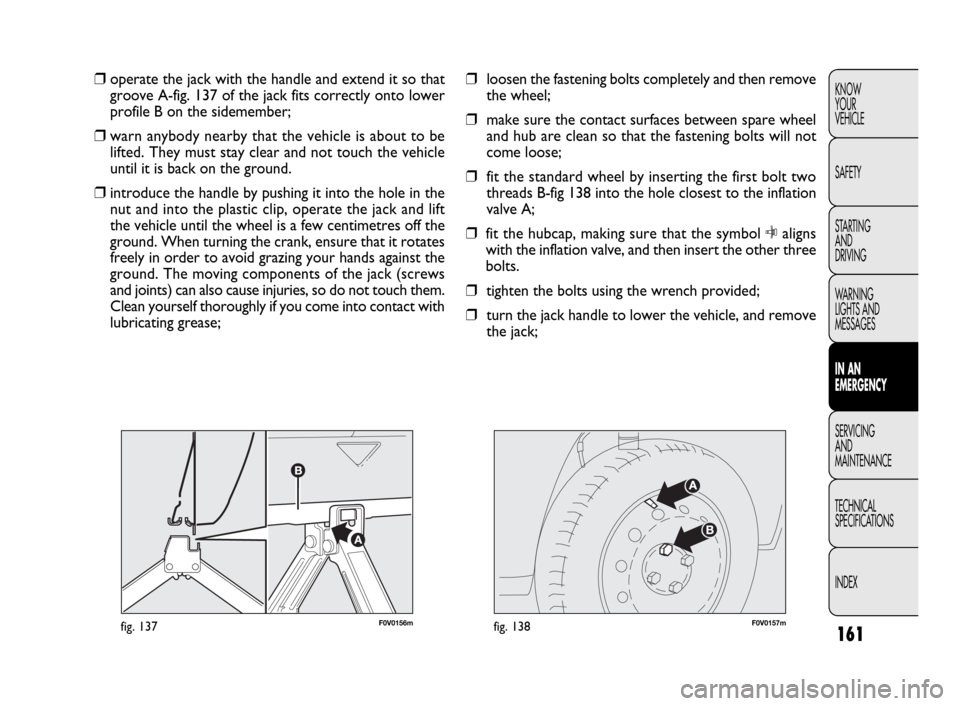
161
KNOW
YOUR
VEHICLE
SAFETY
STARTING
AND
DRIVING
WARNING
LIGHTS AND
MESSAGES
IN AN
EMERGENCY
SERVICING
AND
MAINTENANCE
TECHNICAL
SPECIFICATIONS
INDEX
F0V0156mfig. 137F0V0157mfig. 138
❒loosen the fastening bolts completely and then remove
the wheel;
❒make sure the contact surfaces between spare wheel
and hub are clean so that the fastening bolts will not
come loose;
❒fit the standard wheel by inserting the first bolt two
threads B-fig 138 into the hole closest to the inflation
valve A;
❒fit the hubcap, making sure that the symbol Caligns
with the inflation valve, and then insert the other three
bolts.
❒tighten the bolts using the wrench provided;
❒turn the jack handle to lower the vehicle, and remove
the jack; ❒operate the jack with the handle and extend it so that
groove A-fig. 137 of the jack fits correctly onto lower
profile B on the sidemember;
❒warn anybody nearby that the vehicle is about to be
lifted. They must stay clear and not touch the vehicle
until it is back on the ground.
❒introduce the handle by pushing it into the hole in the
nut and into the plastic clip, operate the jack and lift
the vehicle until the wheel is a few centimetres off the
ground. When turning the crank, ensure that it rotates
freely in order to avoid grazing your hands against the
ground. The moving components of the jack (screws
and joints) can also cause injuries, so do not touch them.
Clean yourself thoroughly if you come into contact with
lubricating grease;
Page 163 of 274
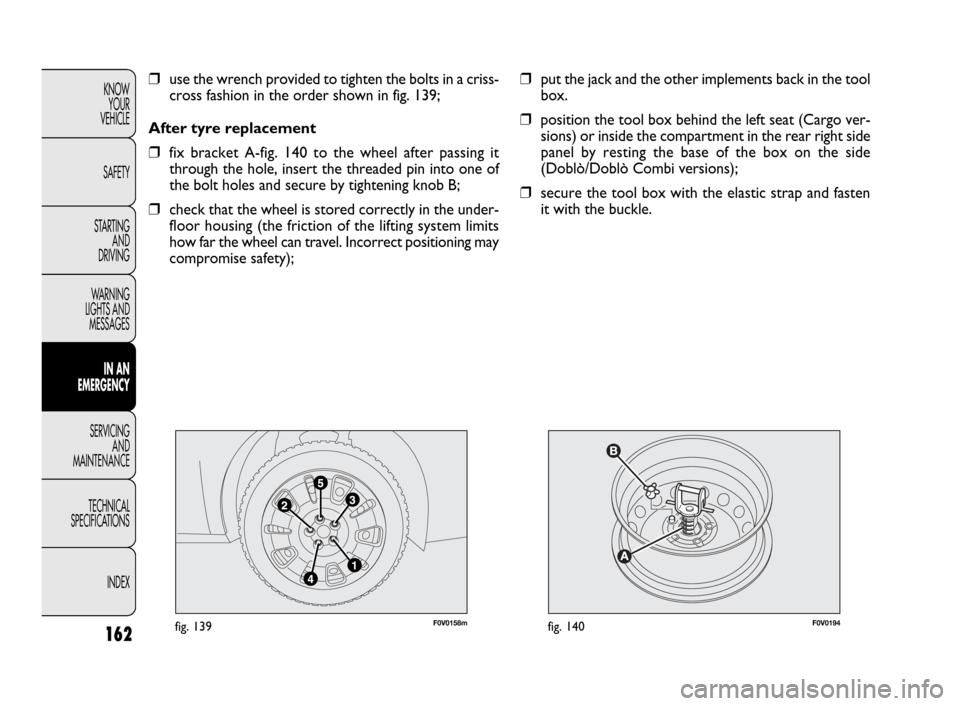
162
KNOW
YOUR
VEHICLE
SAFETY
STARTING
AND
DRIVING
WARNING
LIGHTS AND
MESSAGES
IN AN
EMERGENCY
SERVICING
AND
MAINTENANCE
TECHNICAL
SPECIFICATIONS
INDEX
F0V0158mfig. 139F0V0194fig. 140
❒put the jack and the other implements back in the tool
box.
❒position the tool box behind the left seat (Cargo ver-
sions) or inside the compartment in the rear right side
panel by resting the base of the box on the side
(Doblò/Doblò Combi versions);
❒secure the tool box with the elastic strap and fasten
it with the buckle. ❒use the wrench provided to tighten the bolts in a criss-
cross fashion in the order shown in fig. 139;
After tyre replacement
❒fix bracket A-fig. 140 to the wheel after passing it
through the hole, insert the threaded pin into one of
the bolt holes and secure by tightening knob B;
❒check that the wheel is stored correctly in the under-
floor housing (the friction of the lifting system limits
how far the wheel can travel. Incorrect positioning may
compromise safety);
Page 164 of 274
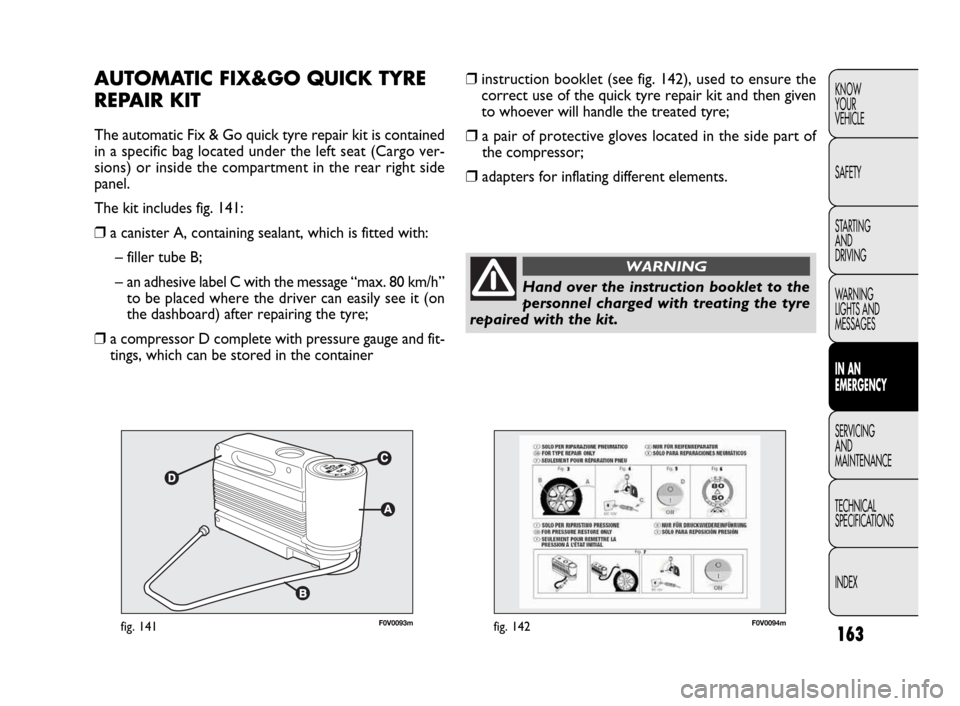
163
KNOW
YOUR
VEHICLE
SAFETY
STARTING
AND
DRIVING
WARNING
LIGHTS AND
MESSAGES
IN AN
EMERGENCY
SERVICING
AND
MAINTENANCE
TECHNICAL
SPECIFICATIONS
INDEX
F0V0093mfig. 141F0V0094mfig. 142
❒instruction booklet (see fig. 142), used to ensure the
correct use of the quick tyre repair kit and then given
to whoever will handle the treated tyre;
❒a pair of protective gloves located in the side part of
the compressor;
❒adapters for inflating different elements.
AUTOMATIC FIX&GO QUICK TYRE
REPAIR KIT
The automatic Fix & Go quick tyre repair kit is contained
in a specific bag located under the left seat (Cargo ver-
sions) or inside the compartment in the rear right side
panel.
The kit includes fig. 141:
❒a canister A, containing sealant, which is fitted with:
– filler tube B;
– an adhesive label C with the message “max. 80 km/h”
to be placed where the driver can easily see it (on
the dashboard) after repairing the tyre;
❒a compressor D complete with pressure gauge and fit-
tings, which can be stored in the container
Hand over the instruction booklet to the
personnel charged with treating the tyre
repaired with the kit.
WARNING
Page 165 of 274
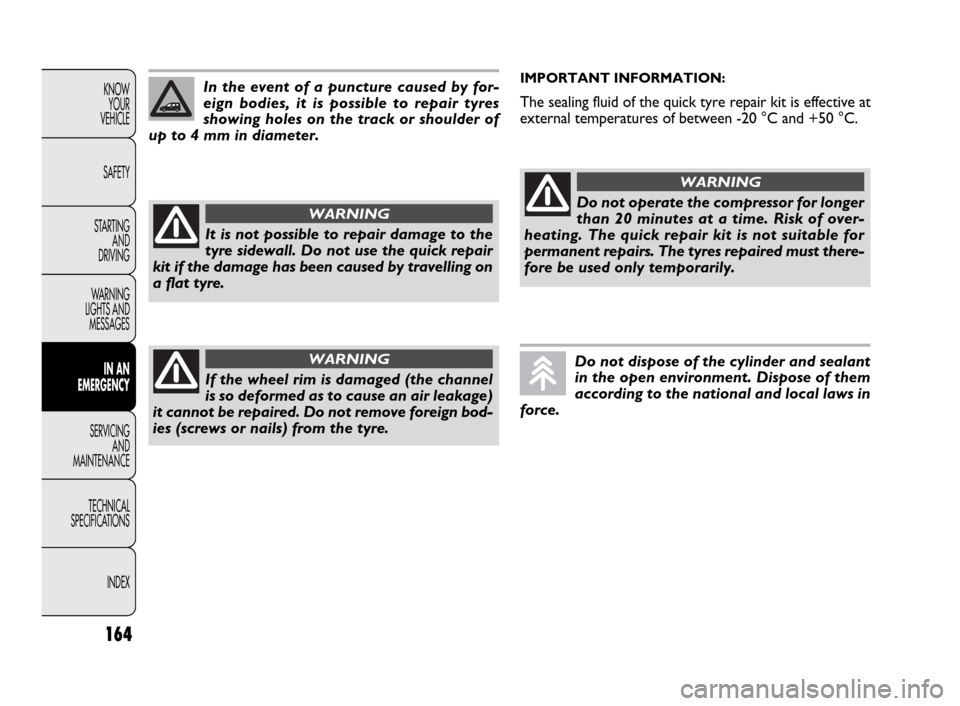
164
KNOW
YOUR
VEHICLE
SAFETY
STARTING
AND
DRIVING
WARNING
LIGHTS AND
MESSAGES
IN AN
EMERGENCY
SERVICING
AND
MAINTENANCE
TECHNICAL
SPECIFICATIONS
INDEXIn the event of a puncture caused by for-
eign bodies, it is possible to repair tyres
showing holes on the track or shoulder of
up to 4 mm in diameter.
It is not possible to repair damage to the
tyre sidewall. Do not use the quick repair
kit if the damage has been caused by travelling on
a flat tyre.
WARNING
If the wheel rim is damaged (the channel
is so deformed as to cause an air leakage)
it cannot be repaired. Do not remove foreign bod-
ies (screws or nails) from the tyre.
WARNING
IMPORTANT INFORMATION:
The sealing fluid of the quick tyre repair kit is effective at
external temperatures of between -20 °C and +50 °C.
Do not operate the compressor for longer
than 20 minutes at a time. Risk of over-
heating. The quick repair kit is not suitable for
permanent repairs. The tyres repaired must there-
fore be used only temporarily.
WARNING
Do not dispose of the cylinder and sealant
in the open environment. Dispose of them
according to the national and local laws in
force.
Page 166 of 274

165
KNOW
YOUR
VEHICLE
SAFETY
STARTING
AND
DRIVING
WARNING
LIGHTS AND
MESSAGES
IN AN
EMERGENCY
SERVICING
AND
MAINTENANCE
TECHNICAL
SPECIFICATIONS
INDEX
F0V0095mfig. 143
INFLATION PROCEDURE
The cylinder contains ethylene glycol. It
contains latex, which may cause an aller-
gic reaction. Harmful if swallowed. Irritates the
eyes. There could be a reaction in case of inhala-
tion or contact. Avoid contact with your eyes, skin
and clothes. In the event of contact, wash imme-
diately with plenty of water. Do not induce vom-
iting if swallowed. Rinse your mouth out and drink
plenty of water. Call a doctor immediately. Keep
out of the reach of children. The product must
not be used by asthmatics. Do not breathe in the
vapours during insertion and suction. Call a doc-
tor immediately if allergic reactions are noted.
Store the canister in its proper compartment,
away from sources of heat. The sealant has an
expiry date. Replace the cylinder if its sealant is
out of date.
WARNING
Put on the protective gloves provided with
the quick tyre repair kit.
WARNING
❒Make sure the handbrake is on. Unscrew the tyre valve
cap, remove the flexible filler tube A-fig. 143 and fas-
ten the nozzle B onto the tyre valve;
Page 167 of 274
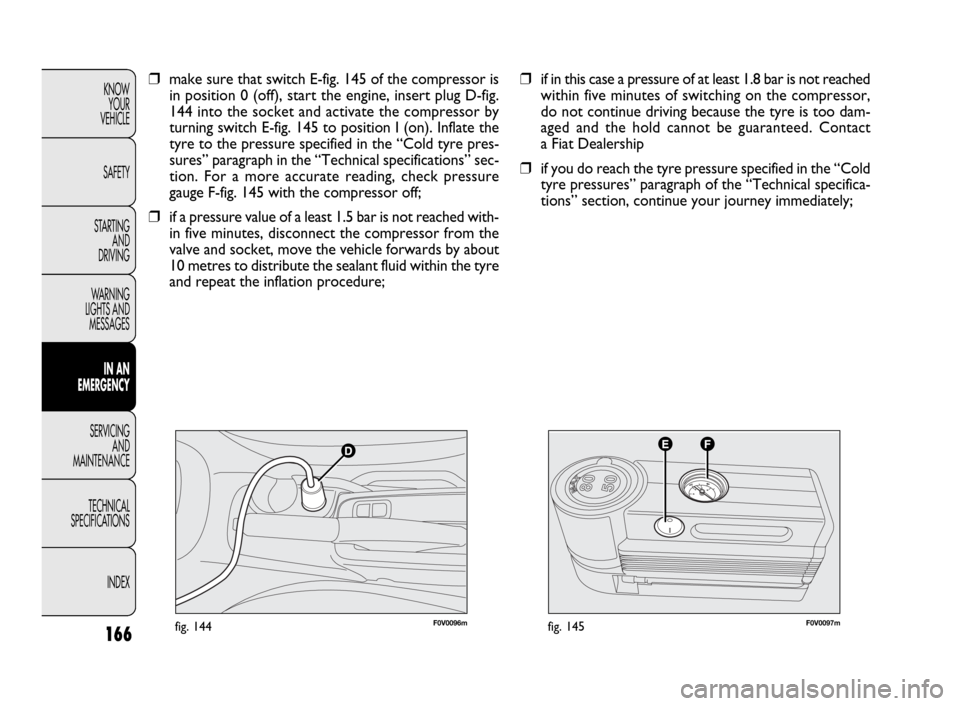
166
KNOW
YOUR
VEHICLE
SAFETY
STARTING
AND
DRIVING
WARNING
LIGHTS AND
MESSAGES
IN AN
EMERGENCY
SERVICING
AND
MAINTENANCE
TECHNICAL
SPECIFICATIONS
INDEX
F0V0096mfig. 144F0V0097mfig. 145
❒if in this case a pressure of at least 1.8 bar is not reached
within five minutes of switching on the compressor,
do not continue driving because the tyre is too dam-
aged and the hold cannot be guaranteed. Contact
a Fiat Dealership
❒if you do reach the tyre pressure specified in the “Cold
tyre pressures” paragraph of the “Technical specifica-
tions” section, continue your journey immediately; ❒make sure that switch E-fig. 145 of the compressor is
in position 0 (off), start the engine, insert plug D-fig.
144 into the socket and activate the compressor by
turning switch E-fig. 145 to position I (on). Inflate the
tyre to the pressure specified in the “Cold tyre pres-
sures” paragraph in the “Technical specifications” sec-
tion. For a more accurate reading, check pressure
gauge F-fig. 145 with the compressor off;
❒if a pressure value of a least 1.5 bar is not reached with-
in five minutes, disconnect the compressor from the
valve and socket, move the vehicle forwards by about
10 metres to distribute the sealant fluid within the tyre
and repeat the inflation procedure;
Page 168 of 274
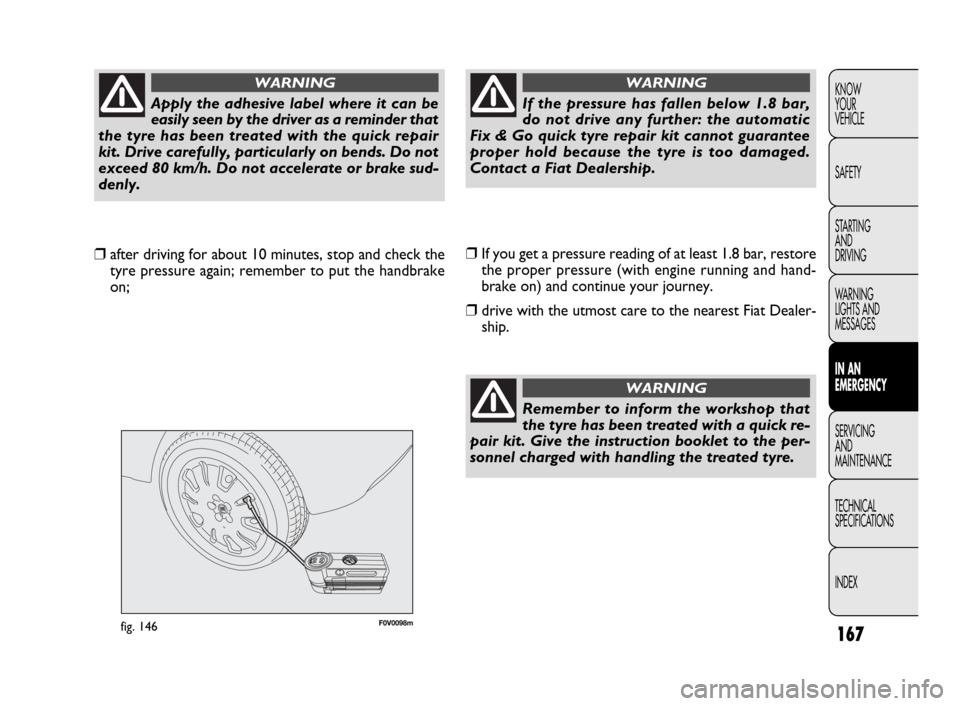
167
KNOW
YOUR
VEHICLE
SAFETY
STARTING
AND
DRIVING
WARNING
LIGHTS AND
MESSAGES
IN AN
EMERGENCY
SERVICING
AND
MAINTENANCE
TECHNICAL
SPECIFICATIONS
INDEX
F0V0098mfig. 146
❒If you get a pressure reading of at least 1.8 bar, restore
the proper pressure (with engine running and hand-
brake on) and continue your journey.
❒drive with the utmost care to the nearest Fiat Dealer-
ship. ❒after driving for about 10 minutes, stop and check the
tyre pressure again; remember to put the handbrake
on;
Apply the adhesive label where it can be
easily seen by the driver as a reminder that
the tyre has been treated with the quick repair
kit. Drive carefully, particularly on bends. Do not
exceed 80 km/h. Do not accelerate or brake sud-
denly.
WARNING
If the pressure has fallen below 1.8 bar,
do not drive any further: the automatic
Fix & Go quick tyre repair kit cannot guarantee
proper hold because the tyre is too damaged.
Contact a Fiat Dealership.
WARNING
Remember to inform the workshop that
the tyre has been treated with a quick re-
pair kit. Give the instruction booklet to the per-
sonnel charged with handling the treated tyre.
WARNING
Page 169 of 274
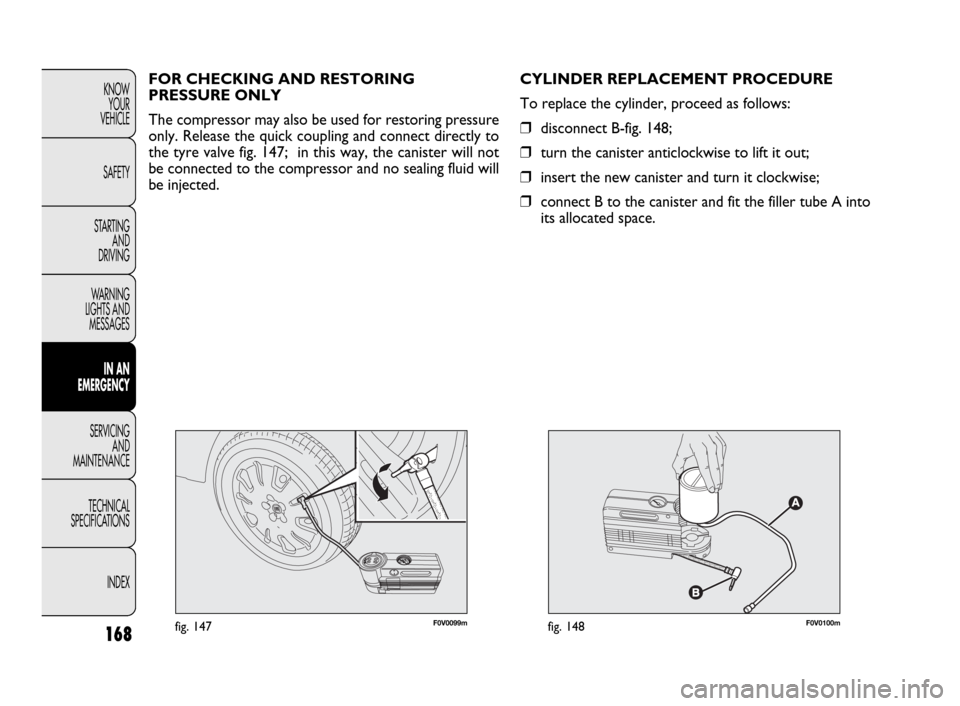
168
KNOW
YOUR
VEHICLE
SAFETY
STARTING
AND
DRIVING
WARNING
LIGHTS AND
MESSAGES
IN AN
EMERGENCY
SERVICING
AND
MAINTENANCE
TECHNICAL
SPECIFICATIONS
INDEX
F0V0099mfig. 147F0V0100mfig. 148
CYLINDER REPLACEMENT PROCEDURE
To replace the cylinder, proceed as follows:
❒disconnect B-fig. 148;
❒turn the canister anticlockwise to lift it out;
❒insert the new canister and turn it clockwise;
❒connect B to the canister and fit the filler tube A into
its allocated space. FOR CHECKING AND RESTORING
PRESSURE ONLY
The compressor may also be used for restoring pressure
only. Release the quick coupling and connect directly to
the tyre valve fig. 147; in this way, the canister will not
be connected to the compressor and no sealing fluid will
be injected.
Page 170 of 274
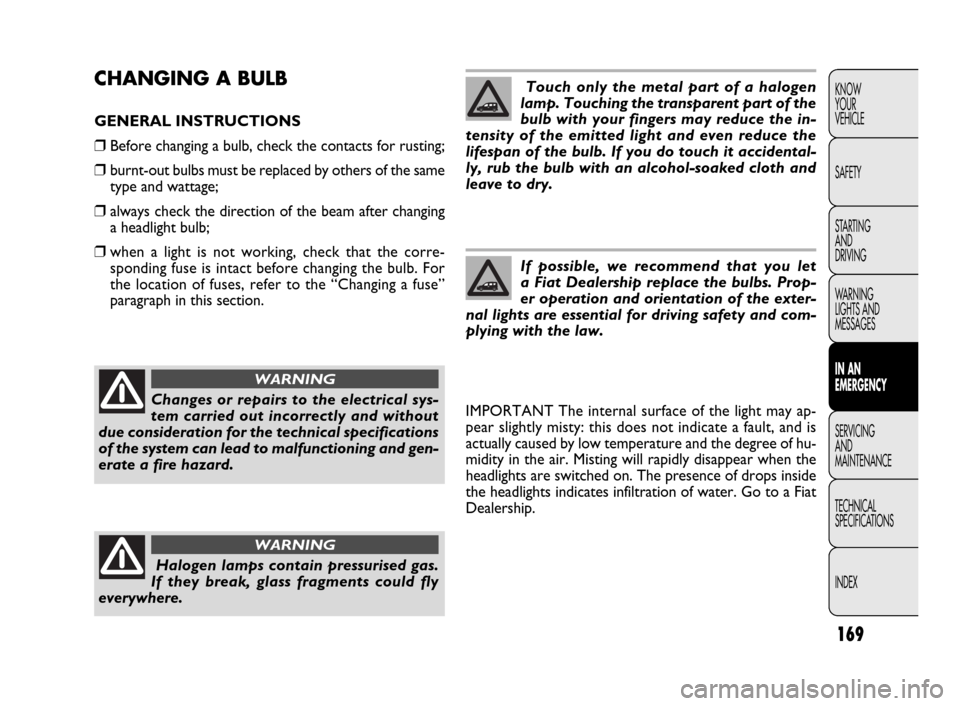
169
KNOW
YOUR
VEHICLE
SAFETY
STARTING
AND
DRIVING
WARNING
LIGHTS AND
MESSAGES
IN AN
EMERGENCY
SERVICING
AND
MAINTENANCE
TECHNICAL
SPECIFICATIONS
INDEXCHANGING A BULB
GENERAL INSTRUCTIONS
❒Before changing a bulb, check the contacts for rusting;
❒burnt-out bulbs must be replaced by others of the same
type and wattage;
❒always check the direction of the beam after changing
a headlight bulb;
❒when a light is not working, check that the corre-
sponding fuse is intact before changing the bulb. For
the location of fuses, refer to the “Changing a fuse”
paragraph in this section.
Changes or repairs to the electrical sys-
tem carried out incorrectly and without
due consideration for the technical specifications
of the system can lead to malfunctioning and gen-
erate a fire hazard.
WARNING
Halogen lamps contain pressurised gas.
If they break, glass fragments could fly
everywhere.
WARNING
Touch only the metal part of a halogen
lamp. Touching the transparent part of the
bulb with your fingers may reduce the in-
tensity of the emitted light and even reduce the
lifespan of the bulb. If you do touch it accidental-
ly, rub the bulb with an alcohol-soaked cloth and
leave to dry.
If possible, we recommend that you let
a Fiat Dealership replace the bulbs. Prop-
er operation and orientation of the exter-
nal lights are essential for driving safety and com-
plying with the law.
IMPORTANT The internal surface of the light may ap-
pear slightly misty: this does not indicate a fault, and is
actually caused by low temperature and the degree of hu-
midity in the air. Misting will rapidly disappear when the
headlights are switched on. The presence of drops inside
the headlights indicates infiltration of water. Go to a Fiat
Dealership.